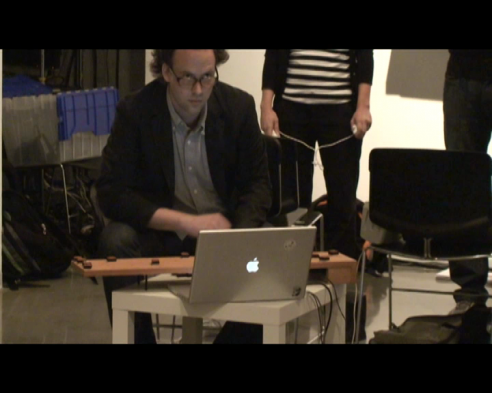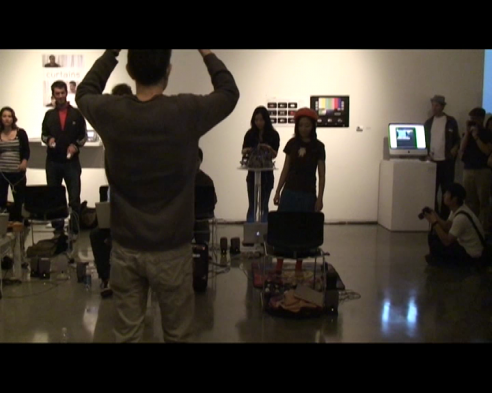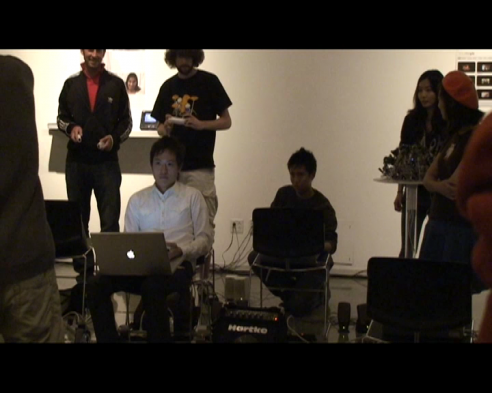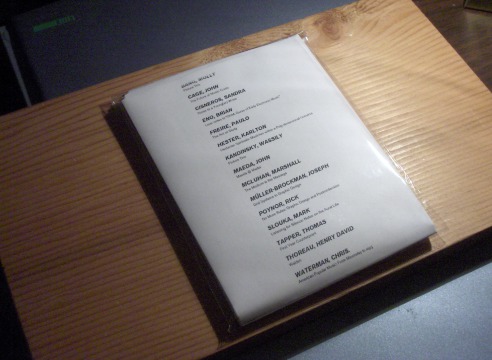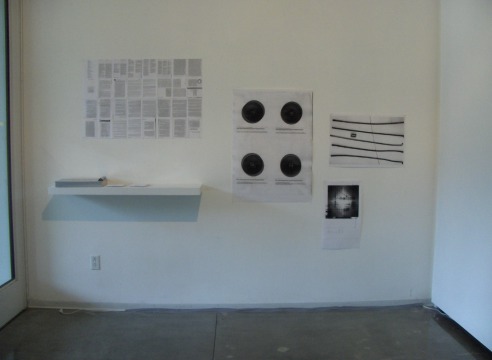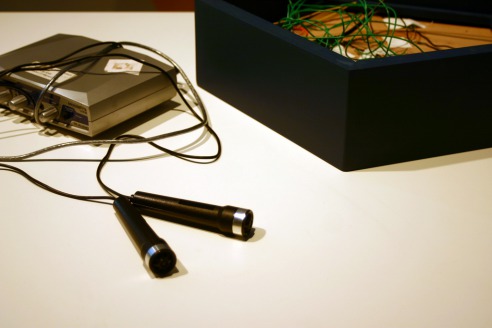🎓
Graduated from UCLA
Bachelors of Arts in Design | Media Arts
June 2009
The B152's
DESMA 152B was a freeform class was led by Professor Chandler McWilliams. The premise was make something using alternative computer interfaces. I took a leadership role and guided the class in the direction towards creating musical instruments and forming a group to perform with our inventions. I developed a conducting language could be used for improvised group performances. Gestures could signal individual performers to navigate in a predetermined musical set of possibilities. At the senior show, I took the role of conductor, while Professor Chandler McWiliams performed on my Photokoto. Our conducting language was influenced by Walter Thompson's "Sound Painting" language. It was also influenced by my experience performing with Synthia Payne.
Links:
- http://en.wikipedia.org/wiki/Soundpainting
- Class website http://classes.dma.ucla.edu/Spring09/152BC/?cat=13
Additional Files:
- Guidelines.pdf
- Video (coming soon)
Final performance on June 4, 2009
Press Me
Press Me is a sculpture, which is interactive by definition, because it has a button. Its shape marks the spot to press the button, and hear a dazzling sound demonstration. The context for the piece however, was for a exhibition of self-portraits. Press Me is medium between me and the viewer. It asks for their participation in the simplest sense. It brings up the question of why is this asking to be pressed and what do both parties gain by this interaction. It deals with the simple fact that no one cares and the vulnerability of putting yourself out there. It deals with the irony that most interactive media is created alone when it is suppose to be social. Programmers are people, too.
The individual handmade synths were created by myself and classmates as part of a workshop led by Brian Crabtree, the creator of the Monome.
Video:
Audio Recordings:
- Audio Recording 1
- Audio Recording 2
Materials: Microcontrollers, Ardunio, Synthesized Audio, Wood, Momentary switch
June 2009
This is a reader in the form of a booklet/poster. It is a collection of writing that influenced me throughout my studies at college. "Trust Yourself" is a quote from Ralph Waldo Emerson from his essay "Self Reliance".
Sources:
Bang, Molly – Picture This
Cage, John – The Future of Music Credo
Cisneros, Sandra – Notes to a Young(er) Writer
Eno, Brian – Liner notes to "OHM, Gurus of Early Electronic Music"
Freire, Paulo – The Act of Study
Hester Karlton – Hesterian Spirituals: Musicism within a Poly-dimensional Universe
Kandinksy, Wassily – ?
Maeda, John – Maeda @ Media
Mcluhan, Marshall – The Medium is the Massage
Muller-Brokeman, Joseph – Grid Systems in Graphic Design
Poynor, Rick – No More Rules: Graphic Design and Postmodernism
Slouka, Mark – Listening for Silence: Notes on Aural Life
Tapper, Thomas – First Year Counterpoint
Thoreau, Henry David – Walden
Waterman, Chris – American Popular Music: From Minstrelsy to mp3
Materials: Large format laser printer. 24x36" paper. 50 copies made.
June 2009
Blinky Chanty Box
Step 1 - One person chants
Step 2 - Match the Leader's Pitch, Sustain as long as you can
Step 3 - If you get tired, pass the mic to a friend
Step 4 - Watch amazing spirits dance in a blinky spectacle of light!
Step 5 - Attain spiritual enLIGHTenment (and inner peace)
A game created in collaboration with Madeleine Gallagher
More Images
Links:
http://games.ucla.edu/game/blinky-chanty-box/
Additional Files:
blinky-instructions-2-25.pdf
Materials: Microphones, LED's, Arduino, Processing
2009
Interactive Choir
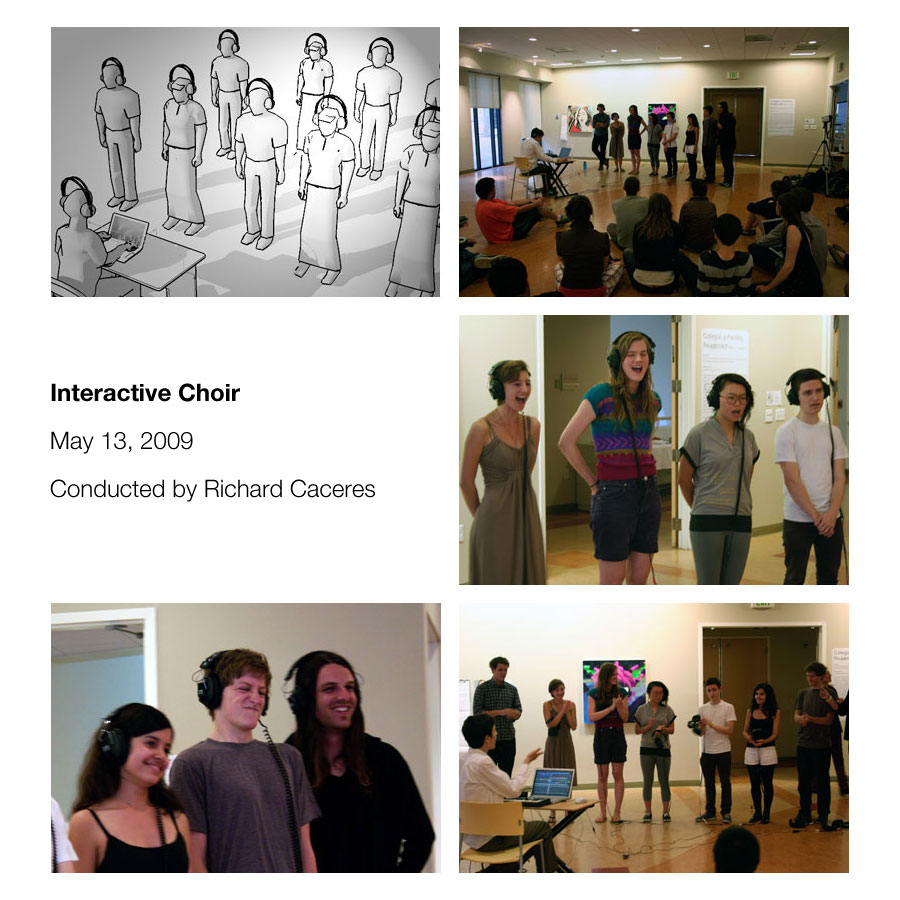
Arranged and conducted by Richard Caceres
Performed by V. Bianqui, M. Daalder, Y. Holzworth, M. Miller, G. Michael-Brower, T. Westhaus, D. Wu, R. York
Performed on May 13, 2009
Using a make-shift audio setup, discrete audio signals were routed and mixed in real-time to eight performers who were instructed to reproduce, as accurately as possible with their voice, the sounds they heard in their headphones. The performance lasted thirty minutes.
The sounds were a mixture of pre-recorded loops and live recordings. The content included spoken poetry, industrial noises, farm sounds, musical harmonies, and more. The choir was made up of new and old friends.
The performance was a made possible through the UCLA Hillel Center and student curators.
Download Full Audio: Download
Materials: USB Audio Interfaces, Eight Pairs of Headphones, Ableton Live
Performed on May 13, 2009
Mysoundworld.com

"[T] first thing an electronic composer does is build a set of instruments, a soundworld." -- Brian Eno
"If this word, music, is sacred and reserved for eighteenth- and nineteenth-century instruments, we can substitute a more meaningful term: organization of sound." -- John Cage
Mysoundworld.com was a minimalist forward-thinking website that allows people to create profiles and upload sound, music, and anything in between. It tries to break out of the mold of bands and albums and instead focuses on individual people and projects. Projects can be ongoing (such as a series) or complete (such as an album). The name might communicate the idea; A "Sound World", or "Worldview in Sound", is one's relationship to the world of sound around them.
It turns out that right around the same time Sound Cloud was being developed. There is a lot of synchronicity between mysoundworld.com and what Sound Cloud would become. For example, both sites were designed to show the waveform.
Unfortunately, mysoundworld.com never made it past the design and prototype stage. It is a lesson in the synchronicity of ideas and how if you have a good idea, someone else probably has the same idea.
Materials: Internet technologies
December 2009
ARTUBE
ARTUBE.us is public access arts television for the internet. Channels are programmed by artists with the hope to share a diverse cultural mix. The different artists are chosen for their unique perspectives they can contribute to the ARTUBE station. The videos are played relative to a constant clock on the ARTUBE server. This simulates the experience of watching television where the viewer cannot skip over content. We believe that sometimes a video is worth watching all the way through even if it does not seem worthy. If the viewer really does not want to watch something, he/she can change the channel. All of ARTUBE's content is streamed from YouTube®. This was a collaboration with Gleb Denisov.
Link: https://artube.us
Materials: Flash, YouTube API
March 2009
Myoo-Zick
Myoo-Zick is a music app for kids. It allows for drag-and-drop creation of music and encourages playfulness and experimentation.
This is a video demonstrating the core functionality and musical capabilities of Myoo-Zick version 1, a music composing program for children. Myoo-Zick is pronounced however you can read it, but it sounds sort-of like "music".
Original idea
A musical sequencer / composer / performer / programmer.
It can be both deterministic and aleatoric.
It can also be automatic with respect to musical rules or theory.
I imagine it as a sort-of Scratch meets Max meets Electro Plankton meets Experiments in Musical Intelligence (EMI) meets Ableton Live.
The intention is to create an easy-to-use application for experimenting with and learning about electronic music composition. The interface also encourages eccentric thinking.
The interface will consist of a palette of musical modules and a canvas. There will be three types of modules: generators, modifiers, and outputs. These will lock into place so that no mistakes can be made. They can be modified or interacted with in real-time to effectively compose. Compositions can be saved and reloaded. Finally, there will be global settings for scale and tempo.
See Original Storyboard: http://classes.dma.ucla.edu/Winter09/152A/projects/richardcaceres/Richard%20Caceres%20-Projectstoryboard.PDF
Download: Download Link
Materials: Processing
March 2009
Dynamic non-looping plasma
Processing implementation of a plasma field that does not use a look-up table for sin values.
Plasma is a computer graphics trick. It is made by cycling through per-calculated sums of sin values. It was popular in hacker demoz and cracktroz. The effect appears psychedelic, which is reminiscent of the relationship between computers and altered states of mind.
This video is a render of 900 frames (5 min) of a plasma program.
This is based code by Lode Vandevenne, which can be found at http://student.kuleuven.be/~m0216922/CG/plasma.html
Materials: Processing
November 2008




